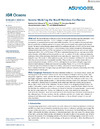Identificador persistente para citar o vincular este elemento:
https://accedacris.ulpgc.es/jspui/handle/10553/55072
| Título: | Inverse Modeling the Brazil-Malvinas Confluence | Autores/as: | Orúe-Echevarría, Dorleta Pelegrí Llopart,José Luis Machín, Francisco Hernández-Guerra, Alonso Emelianov, Mikhail |
Clasificación UNESCO: | 2510 Oceanografía | Fecha de publicación: | 2019 | Editor/a: | 2169-9275 | Proyectos: | Contribución de Las Corrientes de Contorno Del Margen Este A la Variabilidad de la Amoc | Publicación seriada: | Journal of geophysical research. Oceans | Resumen: | The Brazil-Malvinas Confluence arises from the frontal encountering of the subtropical Brazil Current and subantarctic Malvinas Current. It displays a complex regional circulation that is accompanied by mesoscale features and thermohaline intrusions. Here we combine altimetry and cruise data to describe the circulation pattern in the upper 2,000m at two spatial scales encircling the frontal system. The major regional features appear south of the confluence latitude at 39-40 degrees S: (a) a relatively weak Malvinas Current near 41 degrees S, 56 degrees W (28.3 +/- 1.4Sv), followed by its cyclonic retroflection; (b) an intense subtropical anticyclone (59.3 +/- 10.7Sv) that replaces the Brazil Current overshoot; and (c) a very intense subantarctic inflow (78.9 +/- 13.7Sv) near 53 degrees W that is maintained through both an upstream (near 42 degrees S) earlier diversion of the Malvinas Current and the cyclonic recirculation of the flow exiting east along the confluence. North of the confluence, the Brazil Current provides a net input of 30.8 +/- 12.0Sv (29.1 +/- 8.3Sv along the slope). The southern inflow splits nearly equal between barotropic and baroclinic contributions while the entire northern flow is essentially baroclinic. These northern and southern inputs add to an eastward along-front transport of 109.7 +/- 15.1Sv, with significant contribution of highly oxygenated, relatively fresh Subantarctic Mode and Antarctic Intermediate Waters (58.7 +/- 5.6Sv). The regional circulation experiences substantial temporal variability, with southern waters flowing into the Brazil-Malvinas Confluence through along-slope and interior pathways and partly recirculating within the subtropical South Atlantic gyre.Plain Language Summary The Brazil Malvinas Confluence is an intense frontal system, the meeting point of the southward Brazil Current, which transports subtropical relatively warm, salty, and poorly oxygenated waters, and the Malvinas Current, carrying subantarctic relatively fresh, cold, and highly oxygenated waters. Here we examine the conditions in the confluence at the time of the TIC-MOC cruise, paying special attention to their previous evolution. South of the confluence (39-40 degrees S), the circulation is characterized by a relatively weak along-slope Malvinas Current and an interior intense dipole while north of the confluence the main current is the along-slope Brazil Current; the southern and northern inputs conduce to a very intense eastward along-front South Atlantic Current. We find that the conditions at the confluence are forced by both the impinging boundary currents and the interior ocean conditions. Further, the confluence is a site where subantarctic waters flow underneath the subtropical layers and recirculate south after experiencing substantial transformations in the subtropical gyre. We may conclude that the confluence acts both as a barrier and a blender of subtropical and subantarctic waters, of especial relevance in the meridional transport of heat and other properties. | URI: | https://accedacris.ulpgc.es/handle/10553/55072 | ISSN: | 2169-9275 | DOI: | 10.1029/2018JC014733 | Fuente: | Journal of Geophysical Research: Oceans[ISSN 2169-9275], v. 124(1), p. 527-554 |
| Colección: | Artículos |
Citas SCOPUSTM
16
actualizado el 08-jun-2025
Citas de WEB OF SCIENCETM
Citations
16
actualizado el 18-ene-2026
Visitas 5
102
actualizado el 10-ene-2026
Descargas
70
actualizado el 10-ene-2026
Google ScholarTM
Verifica
Altmetric
Comparte
Exporta metadatos
Los elementos en ULPGC accedaCRIS están protegidos por derechos de autor con todos los derechos reservados, a menos que se indique lo contrario.
